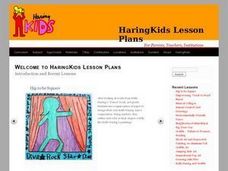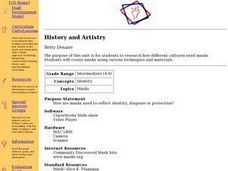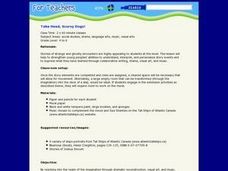Curated OER
Memo from the Governor
Fourth graders inquire about the history of Florida's capital after receiving a mock memo from the governor.
Curated OER
What's the Problem?
Fourth graders redefine the problem of Where's the Heart of Florida? and begin to formulate possible solutions using graphic organizers.
Curated OER
Anecdotes from Artifacts
Students use clay to create a personally meaningful and symbolic artifact. They interpret the artifacts in writing and read about the use of symbols in Native American art.
Curated OER
Tessellation Quilt Squares
Fifth graders design a "quilt block" that has a tessellating pattern to help create a class tessellation quilt. They describe relationships between two- and three-dimensional shapes and analyze attributes and properties of geometric...
Curated OER
The Original Layout of the Town of Deerfield
Eleventh graders explain that elements of the early settlement of Deerfield can still be seen in the town layout and in some of the early 18th century houses which survive. They read and analyze historical maps and analyze a drawing of...
Curated OER
One Person's Garbage, Another Person's . . .?
Students list many, different and unusual items that could be constructed out of refuse and found objects.
Curated OER
Mixing Up Magic
Students explore the relationship between art and science through experimenting with color, design and recycled materials and creating their own art work.
Curated OER
Making Steel: An Awesome Process
Students identify the six basic stages used to create a steel component, and explain how each stage influences or interacts with another. They give examples of how technology has improved human lives.
Curated OER
Religion And Magic
Students examine the indigenous religions of China (Daoism) and Japan (Shinto) to see how magical beliefs and practices form an integral part of these religions. This lesson may be controversial.
Curated OER
History and Artistry
Students explore the ways masks are used in various occupations and cultural ceremonies through readings, a play performance and guest speakers. They create a clay mask and a found art mask using principles of symmetry. After creating...
Curated OER
Building Buildings
Young scholars work together with a partnet to design a building. Using materials, they create the inside and outside of the structure along with works of art. They present their creation to the class and receive constructive criticism...
Curated OER
Take Heed, Scurvy Dogs!
Students examine the use of ghosts in shipping stories. As a class, they assign roles and they act them out in a play. They make it seem as if they are in danger on their voyage and work together to create a script. They ask questions...
Curated OER
Definition and Applications of Computational Science
Students participate in a variety of instructional experiences about Computer Science. They define Computational Science and describe computational simulation. They also compare and contrast Computational Science and Computer Science.
Curated OER
Round to the Nearest Whole $
In this rounding money worksheet, students identify the money amounts in each examples and round to the nearest dollar for the 10 examples.
Curated OER
Symmetry: Theory, Reality and Art!
Students explore the concept of geometric symmetry. For this geometric symmetry lesson, students walk around their school and take pictures of objects that demonstrate symmetry. Students use Microsoft Paint to draw the lines of symmetry...
Curated OER
Personal Observations
Students determine the appropriate clothing for warm and cold weather. In this weather and clothing lesson, students draw and describe appropriate clothing for cold and warm weather.

















